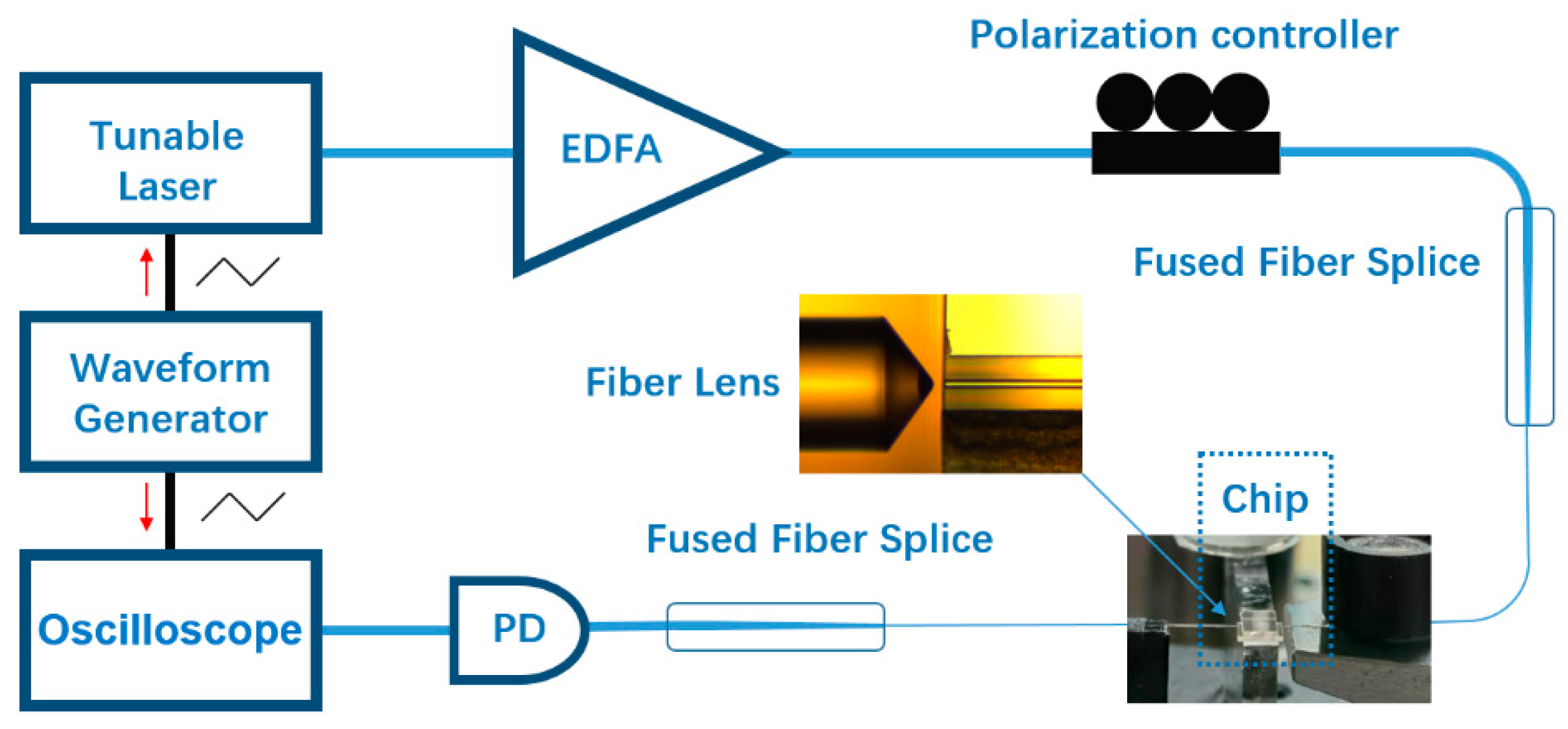An Ultra-High-Q Lithium Niobate Microresonator Integrated with a Silicon Nitride Waveguide in the Vertical Configuration for Evanescent Light Coupling
Abstract
1. Introduction
2. Materials and Methods
3. Results
4. Conclusions
Author Contributions
Funding
Conflicts of Interest
References
- Boes, A.; Corcoran, B.; Chang, L.; Bowers, J.; Mitchell, A. Status and potential of lithium niobate on insulator (LNOI) for photonic integrated circuits. Laser Photon. Rev. 2018, 12, 1700256. [Google Scholar] [CrossRef]
- Diziain, S.; Geiss, R.; Zilk, M.; Schrempel, F.; Kley, E.-B.; Tünnermann, A.; Pertsch, T. Mode analysis of photonic crystal L3 cavities in self-suspended lithium niobate membranes. Appl. Phys. Lett. 2013, 103, 251101. [Google Scholar] [CrossRef]
- Zhang, M.; Wang, C.; Cheng, R.; Shams-Ansari, A.; Lončar, M. Monolithic ultra-high-Q lithium niobate microring resonator. Optica 2017, 4, 1536–1537. [Google Scholar] [CrossRef]
- Hu, H.; Yang, J.; Gui, L.; Sohler, W. Lithium niobate-on-insulator (LNOI): Status and perspectives. Proc. SPIE 2012, 8431, 84311D. [Google Scholar]
- Geiss, R.; Saravi, S.; Sergeyev, A.; Diziain, S.; Setzpfandt, F.; Schrempel, F.; Grange, R.; Kley, E.-B.; Tünnermann, A.; Pertsch, T. Fabrication of nanoscale lithium niobate waveguides for second-harmonic generation. Opt. Lett. 2015, 40, 2715–2718. [Google Scholar] [CrossRef]
- Luo, R.; He, Y.; Liang, H.; Li, M.; Lin, Q. Semi-nonlinear nanophotonic waveguides for highly efficient second-harmonic generation. Laser Photon. Rev. 2019, 13, 1800288. [Google Scholar] [CrossRef]
- Krasnokutska, I.; Tambasco, J.L.J.; Li, X.J.; Peruzzo, A. Ultra-low loss photonic circuits in lithium niobate on insulator. Opt. Express 2018, 26, 887–894. [Google Scholar] [CrossRef]
- Lu, J.; Surya, J.B.; Liu, X.; Xu, Y.; Tang, H.X. Octave-spanning supercontinuum generation in nanoscale lithium niobate waveguides. Opt. Lett. 2019, 44, 1492–1495. [Google Scholar] [CrossRef]
- He, M.; Xu, M.; Ren, Y.; Jian, J.; Ruan, Z.; Xu, Y.; Gao, S.; Sun, S.; Wen, X.; Zhou, L.; et al. High-performance hybrid silicon and lithium niobate Mach–Zehnder modulators for 100 Gbit s−1 and beyond. Nat. Photon. 2019, 13, 359–364. [Google Scholar] [CrossRef]
- Chen, J.-Y.; Ma, Z.-H.; Sua, Y.M.; Li, Z.; Tang, C.; Huang, Y.-P. Ultra-efficient frequency conversion in quasi-phase-matched lithium niobate microrings. Optica 2019, 6, 1244–1245. [Google Scholar] [CrossRef]
- Luo, R.; He, Y.; Liang, H.; Li, M.; Lin, Q. Highly tunable efficient second-harmonic generation in a lithium niobate nanophotonic waveguide. Optica 2018, 5, 1006–1011. [Google Scholar] [CrossRef]
- Wu, R.; Zhang, J.; Yao, N.; Fang, W.; Qiao, L.; Chai, Z.; Lin, J.; Cheng, Y. Lithium niobate micro-disk resonators of quality factors above 107. Opt. Lett. 2018, 43, 4116–4119. [Google Scholar] [CrossRef] [PubMed]
- Zhang, J.; Fang, Z.; Lin, J.; Zhou, J.; Wang, M.; Wu, R.; Gao, R.; Cheng, Y. Fabrication of crystalline microresonators of high quality factors with a controllable wedge angle on lithium niobate on insulator. Nanomaterials 2019, 9, 1218. [Google Scholar] [CrossRef] [PubMed]
- Wu, R.B.; Wang, M.; Xu, J.; Qi, J.; Chu, W.; Fang, Z.W.; Zhang, J.H.; Zhou, J.X.; Qiao, L.L.; Chai, Z.F.; et al. Long low-loss-litium niobate on insulator waveguides with sub-nanometer surface roughness. Nanomaterials 2018, 8, 910. [Google Scholar] [CrossRef] [PubMed]
- Jiang, W.C.; Lin, Q. Chip-scale cavity optomechanics in lithium niobate. Sci. Rep. 2016, 36920. [Google Scholar] [CrossRef] [PubMed]
- Zhang, M.; Buscaino, B.; Wang, C.; Shams-Ansari, A.; Reimer, C.; Zhu, R.; Kahn, J.M.; Lončar, M. Broadband electro-optic frequency comb generation in a lithium niobate microring resonator. Nature 2019, 568, 373–377. [Google Scholar] [CrossRef] [PubMed]
- Fang, Z.; Haque, S.; Farajollahi, S.; Luo, H.; Lin, J.; Wu, R.; Zhang, J.; Wang, Z.; Wang, M.; Cheng, Y.; et al. Polygon coherent modes in a weakly perturbed whispering gallery microresonator for efficient second harmonic, optomechanical, and frequency comb generations. Phys. Rev. Lett. 2020, 125, 173901. [Google Scholar] [CrossRef] [PubMed]
- Wang, L.; Wang, C.; Wang, J.; Bo, F.; Zhang, M.; Gong, Q.; Lončar, M.; Xiao, Y.-F. High-Q chaotic lithium niobate microdisk cavity. Opt. Lett. 2018, 43, 2917. [Google Scholar] [CrossRef] [PubMed]
- Wolf, R.; Breunig, I.; Zappe, H.; Buse, K. Scattering-loss reduction of ridge waveguides by sidewall polishing Opt. Express 2018, 26, 19815–19820. [Google Scholar] [CrossRef]
- Pant, M.; Towsley, D.; Englund, D.; Guha, S. Percolation thresholds for photonic quantum computing. Nat. Commun. 2019, 10, 1070. [Google Scholar] [CrossRef] [PubMed]






Publisher’s Note: MDPI stays neutral with regard to jurisdictional claims in published maps and institutional affiliations. |
© 2021 by the authors. Licensee MDPI, Basel, Switzerland. This article is an open access article distributed under the terms and conditions of the Creative Commons Attribution (CC BY) license (http://creativecommons.org/licenses/by/4.0/).
Share and Cite
Zhang, J.; Wu, R.; Wang, M.; Liang, Y.; Zhou, J.; Wu, M.; Fang, Z.; Chu, W.; Cheng, Y. An Ultra-High-Q Lithium Niobate Microresonator Integrated with a Silicon Nitride Waveguide in the Vertical Configuration for Evanescent Light Coupling. Micromachines 2021, 12, 235. https://doi.org/10.3390/mi12030235
Zhang J, Wu R, Wang M, Liang Y, Zhou J, Wu M, Fang Z, Chu W, Cheng Y. An Ultra-High-Q Lithium Niobate Microresonator Integrated with a Silicon Nitride Waveguide in the Vertical Configuration for Evanescent Light Coupling. Micromachines. 2021; 12(3):235. https://doi.org/10.3390/mi12030235
Chicago/Turabian StyleZhang, Jianhao, Rongbo Wu, Min Wang, Youting Liang, Junxia Zhou, Miao Wu, Zhiwei Fang, Wei Chu, and Ya Cheng. 2021. "An Ultra-High-Q Lithium Niobate Microresonator Integrated with a Silicon Nitride Waveguide in the Vertical Configuration for Evanescent Light Coupling" Micromachines 12, no. 3: 235. https://doi.org/10.3390/mi12030235
APA StyleZhang, J., Wu, R., Wang, M., Liang, Y., Zhou, J., Wu, M., Fang, Z., Chu, W., & Cheng, Y. (2021). An Ultra-High-Q Lithium Niobate Microresonator Integrated with a Silicon Nitride Waveguide in the Vertical Configuration for Evanescent Light Coupling. Micromachines, 12(3), 235. https://doi.org/10.3390/mi12030235






